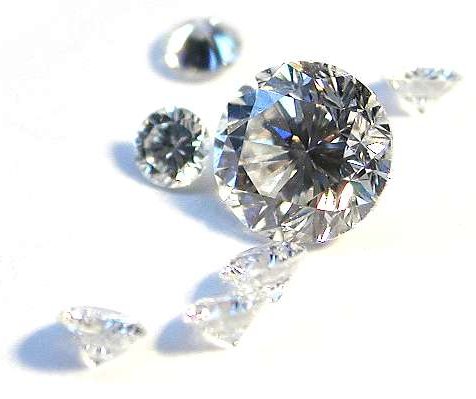An Introduction to the Hanneman Diamond Cut Grading System, Lesson One
With the Hanneman diamond cut grading system, you can derive the cut grade of any round brilliant with minimal measurements and calculations. Start learning this simplified system here.
3 Minute Read
Diamond Cut Grading Simplified: A Basic Course
The cut grade of any round brilliant diamond can be derived from the knowledge of four measurements, two equations, and a table of 12 numbers. The measurements are:
The equations are C/P = 0.84 and H = 58.3 + 3. The table is printed below.
This information can also be used to evaluate the relative severity of any commercial grading system or laboratory. Simply plug in their numbers and compare the results.
The Hanneman Diamond Cut Grading System
OK. Now that I have your attention, I'll give you the next couple of paragraphs. First, let me say this. Every diamond in every jewelry store, under the bright lights of the sales counter, looks good to someone. If it is pretty, you like it, and the price is right, buy it. Be happy and read no further. But then, how can you know if the price is right, if you don't know its cut grade?
Learning to cut grade a diamond is not rocket science. When all is said and done, the final result is expressed in one or two words like "Good" or "Very Good," letters like A or B, a relative number like 1 or 2, or a fancy one like I or II. All the rest is just "window dressing," designed to make a customer feel better for the fee paid for that report or an attempt to "justify" the subjective opinion just rendered.
For about $1,300 plus travel, lodging, and four days of your time, you can have all this spoon fed to you. Or, you can read the following few words and learn how anyone can derive the same, no, actually more useful, information faster and easier.
The only reason for grading a diamond is to assign a relative value to that stone. However, since each grading laboratory sets its own entirely subjective proprietary limits on their grade requirements, accurate comparisons are impossible. What one lab calls "Good" may be another lab's "Very Good." Still, the trade understands this, and that explains why some grade reports are recognized as being more desirable than others. As a seller, one desires lenient grading, while buyers prefer stricter standards.
C/P Ranges for "Top Quality" Classifications by Various Labs
A few years ago, based upon the requirements for a "top quality" classification, the severity of grading by various labs roughly followed the order shown below.
| Lab | C/P Range |
| AGA | 0.83 - 0.85 |
| AGT | 0.81 - 0.86 |
| CGL | 0.80 - 0.86 |
| AGJ | 0.80 - 0.87 |
| AGS | 0.81 - 0.89 |
| IGI | 0.80 - 0.90 |
The current Gemological Institute of America (GIA) system, as taught to students, would rank next to the top with C/P = 0.81 - 0.85. This, alone, despite their ballyhooed denial of its existence, confirms GIA's belief in an ideal cut.
For the present, don't concern yourself with those C/P values. That is what this "course" is all about. Soon, you will learn how to convert the data from any "Diamond Report" to an objective "Universal" rating in less than two minutes. Just be patient. First, you have to jump through a few hoops.
Homework Assignment
- Visit one or more local jewelry stores or contact them by phone and tell them you would like to know their prices for a 3/4 carat solitary round brilliant cut diamond ring, or the price of an equivalent unmounted stone. They should have several levels of quality from which to choose.
- For each level, record the data supplied on its grade report regarding the 4Cs: carat, color, clarity, and cut. You really don't need the data on color and clarity, but they will think you are some kind of a nut if you don't ask.
- Ask for the following information from their grading report: diameter, height, crown angle, and pavilion angle, and any other information or notations they would like to give you. At a minimum, you should get data for diameter and total height or depth.
- Collect similar data for six different stones. If possible, collect data for two each in categories the seller regards as his good, better, and best qualities. If that is not possible, try to get data for three good, two better, and one best quality.
- Too lazy to do this right? Just make up some numbers you think look good. We will show you how to cut grade those stones you "created."
The Hanneman Diamond Cut Grading System Series
- Introduction, Lesson One
- Basic Proportions, Lesson Two
- Grading Categories, Lesson Three
- Evaluating the Cut, Lesson Four
William Hanneman
W. William Hanneman, Ph.D. is a retired research analytical chemist. Gemology is his hobby. He has authored several books, guides, and toolsets based on his unique chemistry based perspective on gemology.
Related Articles
Exposing Diamond Overgrading at EGL Labs
Can Blockchain Diamonds Solve Ethical Sourcing and Grading Issues?
Diamond Rating: A Beginner’s Guide
The GIA Diamond Cut Grading System
Latest Articles
800 Years of Mogok: A Celebration in Tenuous Times
What is the Average Gemstone Faceting Yield?
Pyroxmangite Value, Price, and Jewelry Information
How to Identify Emerald Simulants and Synthetics
Never Stop Learning
When you join the IGS community, you get trusted diamond & gemstone information when you need it.
Get Gemology Insights
Get started with the International Gem Society’s free guide to gemstone identification. Join our weekly newsletter & get a free copy of the Gem ID Checklist!
